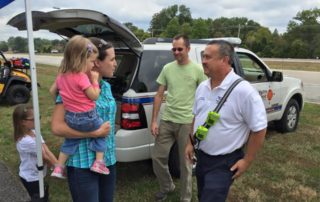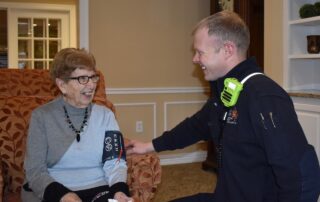Technology that helps our community save lives

You know the difference early CPR and defibrillation can make in a Sudden Cardiac Arrest event. Fifty-seven percent of U.S. adults say they’ve had CPR training, and most would be willing to use CPR or an AED to help save a stranger’s life. Yet only 11% say they’ve used CPR in an actual emergency—that’s a number we can increase together.
When that emergency call comes in your team will be ready. But what if someone was already at the scene, applying lifesaving CPR and defibrillation until the EMS team arrived? Where adopted, PulsePoint Respond empowers everyday citizens to provide life‐saving assistance to victims of sudden cardiac arrest.App users who have indicated they are trained in cardiopulmonary resuscitation (CPR) and willing to assist in case of an emergency can be notified if someone nearby is having a cardiac emergency and may require CPR.If the cardiac emergency is in a public place, the location-aware application will alert users in the vicinity of the need for CPR simultaneous with the dispatch of advanced medical care. The application also directs these potential rescuers to the exact location of the closest Automated External Defibrillator (AED).
PulsePoint AED lets you report and update AED locations so that emergency responders, including nearby citizens trained in CPR and off-duty professionals such as firefighters, police officers and nurses, can find an AED close to them when a cardiac emergency occurs. The AEDs that you locate and report using PulsePoint AED are also made available to local dispatchers in the emergency communication center, allowing them to direct callers to the nearby life-saving devices.
Development of the PulsePoint app began in June, 2009 as a partnership between the San Ramon Valley Fire Protection District (SRVFPD) and the College of Informatics at Northern Kentucky University (NKU). The application was originally released in the Apple App Store in April, 2010. At a meeting in February, 2011 the Board of Directors of the SRVFPD established a committee to address the affairs related to the application, including the transfer of responsibility for the software to an independent and external non-profit foundation. This ultimately resulted in the formation of the PulsePoint Foundation to oversee the future direction of the application.
Research Studies
- Mobile-Phone Dispatch of Laypersons for CPR in Out-of-Hospital Cardiac Arrest
- Lay persons alerted by mobile application system initiate earlier cardio-pulmonary resuscitation: a comparison with SMS- based system notification
- Real-life time and distance covered by lay first responders alerted by means of smartphone-application: Implications for early initiation of cardiopulmonary resuscitation and access to automatic external defibrillators
- A text message alert system for trained volunteers improves out-of-hospital cardiac arrest survival
- Use of Mobile Devices, Social Media, and Crowdsourcing as Digital Strategies to Improve Emergency Cardiovascular Care
- Early Cardiopulmonary Resuscitation in Out-of-Hospital Cardiac Arrest
- Lay Responder Care for an Adult with Out-of-Hospital Cardiac Arrest
- Bystander Efforts and 1-Year Outcomes in Out-of-Hospital Cardiac Arrest
- Strategies to Improve Cardiac Arrest Survival: A Time to Act









































